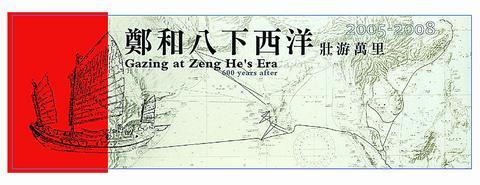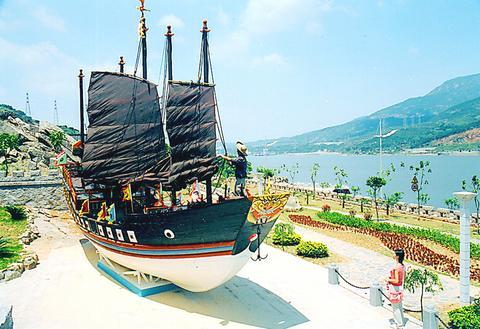In July 1405, Admiral Zheng He (
Six hundred years later, in July next year, Zheng's voyage will be recreated, with volunteers from Chinese societies. The expedition team is called "Gazing at Zheng He's Era, 600 years After, 2005 to 2008 (鄭和八下西洋探險隊, 2005 -- 2008).
"We want to commemorate Zheng as the first hero in the history of Chinese sea exploration. And we want to look for the kind of adventurous spirit and the peace-loving mind and generosity which was demonstrated in Zheng's journeys," said Alan Hsu (

After the Taipei press conference on Dec. 19, the society held another press conference in Beijing, announcing its recruiting project. "We want people from the four regions of Chinese society to come join us," Hsu said.
At the preliminary stage, the society will choose 30 members and 10 substitute members. After a few months of training, the team will be wittled down to 10 people, as the final number of team members.
"Ideally, we hope to have four from Taiwan, four from China, one from Hong Kong and one from Macao," Hsu said.

If all goes well, "Gazing at Zheng He's Era" will be a rare sea adventure in the Chinese-speaking world. In previous years, in Taiwan and China, there have been various events sponsored by the public and private sectors to commemorate Zheng's historical achievement.
July 11 has been set by the Taiwan government as "Sailing Day" (
In China, museums, monuments and academic research institutes that celebrate Zheng's achievements have been launched.
Last May, Taitsang City -- the original port of departure for his journeys -- held the first Zheng He Sailing Festival.
But the first adventure event celebrating the 600th anniversary of Zheng's voyage was started by a Taiwanese non-profit organization.
"Anyone over 20 years old, from any of the four regions, are eligible to apply. This will be an unforgettable experience and achievement for anyone involved in the project," Hsu said.
One particular attraction of the trip is that it will painstakingly recreate the conditions and tools of the time. After two years of research, SEE Taiwan has found junk-building masters from Fujian, Zhejiang and Jiansu provinces.
The society is still looking for a suitable shipbuilding plant and it is estimated that it will take about 10 months to a year to finish building. The cost, according to Hsu, willl be around NT$90 million. The boat will be 25m long, 5.5m wide and about 60 tonnes to 70 tonnes, Hsu said -- several times smaller than the size of the giant junks used in the Ming dynasty.
The replica junk will be installed with an engine and modern navigation technologies such as a GPRS navigation system, weather maps and a computer system. It is, according to Hsu, a motorized junk.
In Zheng's time, of course, the fleet was entirely dependent on wind. The fleet set off from Taitsang and stopped at the ports of Changle City (
For the journey next year wind power will be harnessed. "We will use the engine only when necessary, for example, to avoid boats when entering a port, or when confronting bad weathers or waves," Hsu said.
According to SEE Taiwan's plan, after about 33 months of voyaging, the team will stop at Taiwan's Kaohsiung and Keelung ports for a few days, and then return to Taitsang City in June, for a closing press conference in Beijing in July. The date will coincide with the opening of the 2008 Olympics Games in Beijing.
But, during the three years of the voyage, what will team members be doing? Zheng He exacted tributes from China's neighbors, participated in religious ceremonies (Zheng was a Muslim) and helped open up trade routes to the Middle East.
This time round, the team members will revisit the relics and monuments Zheng left in countries such as Malaysia, Indonesia, Sri Lanka, India, Yemen and Saudi Arabia. Also, history researchers from the Chinese Social Science Academy will do field research during the journey. One of the team members will be responsible for making a documentary film about the three-year voyage.
"And don't forget, we have to be careful about the pirates on the sea," said Peter Yu (
Established in 1999, SEE Taiwan's first exploration activity was "Trekking Without Genghis Khan, 800 Years Later" (
Alan Hsu, the initiator and organizer of SEE Taiwan, is himself a fanatic for adventure. From 1985 to 1987, Hsu and three companions went on a trek of 15,000km around the globe, becoming the first four Taiwanese to walk around the world.
After being a journalist concentrating on outdoor and exploration activities for 10 years, Hsu decided to quit the job and started his Society of Extreme Exploration.
"It's not only just my personal interest. I think in each country or culture, there is a need for the spirit of exploration and adventure. This is particularly deficient in Taiwan," he said.
For more information to apply for the expedition team:
Contact the Society of Extreme Exploration by calling (02) 2933 6075
www.zheng-he.org http://www.zheng-he.org

April 14 to April 20 In March 1947, Sising Katadrepan urged the government to drop the “high mountain people” (高山族) designation for Indigenous Taiwanese and refer to them as “Taiwan people” (台灣族). He considered the term derogatory, arguing that it made them sound like animals. The Taiwan Provincial Government agreed to stop using the term, stating that Indigenous Taiwanese suffered all sorts of discrimination and oppression under the Japanese and were forced to live in the mountains as outsiders to society. Now, under the new regime, they would be seen as equals, thus they should be henceforth

Last week, the the National Immigration Agency (NIA) told the legislature that more than 10,000 naturalized Taiwanese citizens from the People’s Republic of China (PRC) risked having their citizenship revoked if they failed to provide proof that they had renounced their Chinese household registration within the next three months. Renunciation is required under the Act Governing Relations Between the People of the Taiwan Area and the Mainland Area (臺灣地區與大陸地區人民關係條例), as amended in 2004, though it was only a legal requirement after 2000. Prior to that, it had been only an administrative requirement since the Nationality Act (國籍法) was established in

With over 80 works on display, this is Louise Bourgeois’ first solo show in Taiwan. Visitors are invited to traverse her world of love and hate, vengeance and acceptance, trauma and reconciliation. Dominating the entrance, the nine-foot-tall Crouching Spider (2003) greets visitors. The creature looms behind the glass facade, symbolic protector and gatekeeper to the intimate journey ahead. Bourgeois, best known for her giant spider sculptures, is one of the most influential artist of the twentieth century. Blending vulnerability and defiance through themes of sexuality, trauma and identity, her work reshaped the landscape of contemporary art with fearless honesty. “People are influenced by

The remains of this Japanese-era trail designed to protect the camphor industry make for a scenic day-hike, a fascinating overnight hike or a challenging multi-day adventure Maolin District (茂林) in Kaohsiung is well known for beautiful roadside scenery, waterfalls, the annual butterfly migration and indigenous culture. A lesser known but worthwhile destination here lies along the very top of the valley: the Liugui Security Path (六龜警備道). This relic of the Japanese era once isolated the Maolin valley from the outside world but now serves to draw tourists in. The path originally ran for about 50km, but not all of this trail is still easily walkable. The nicest section for a simple day hike is the heavily trafficked southern section above Maolin and Wanshan (萬山) villages. Remains of